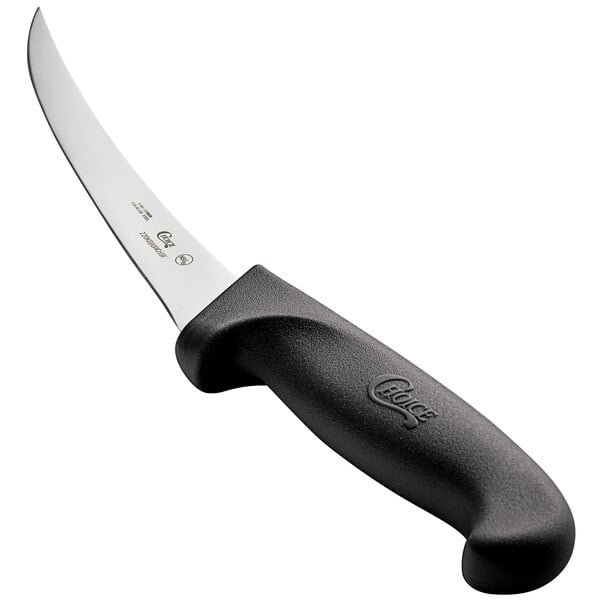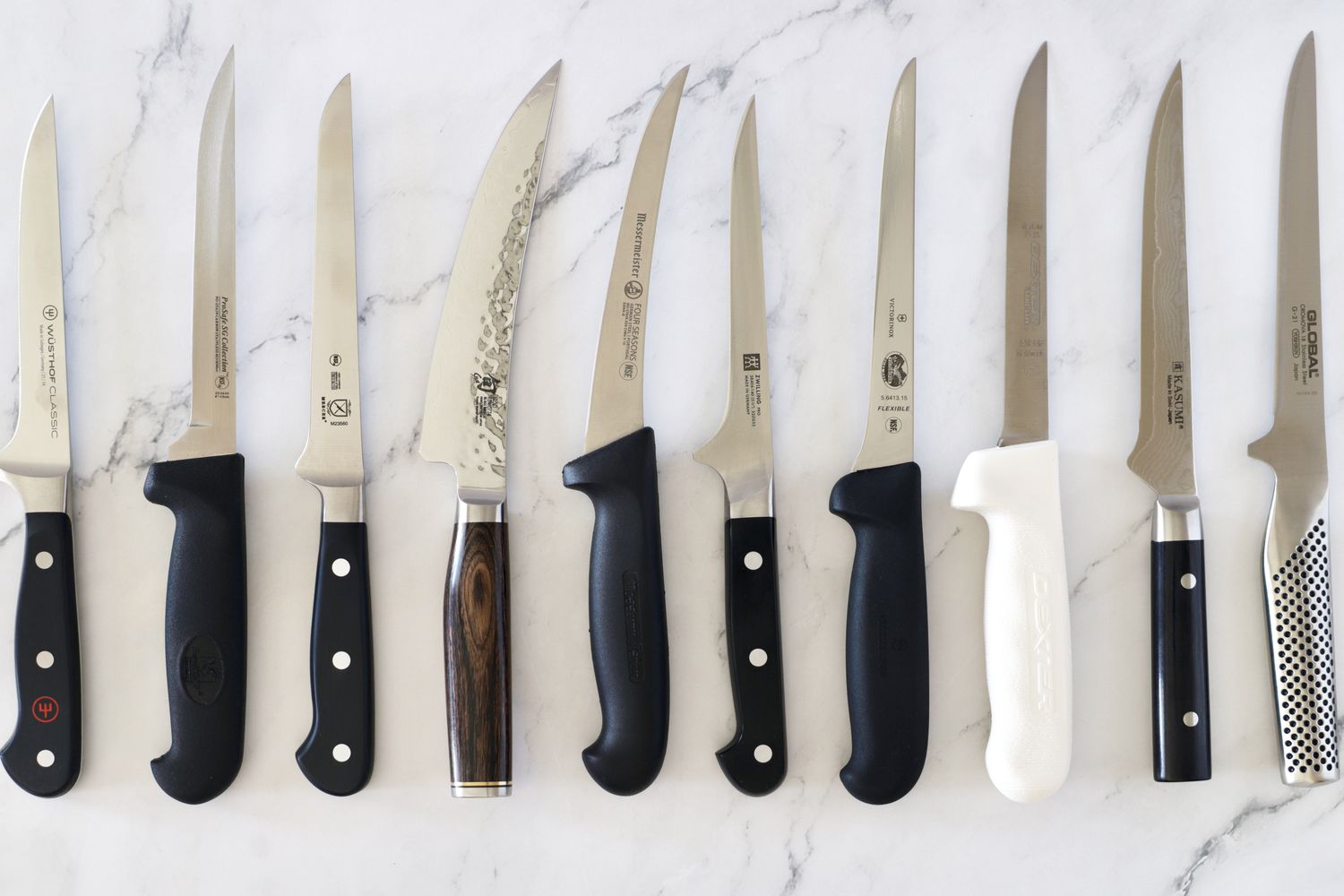When choosing a boning knife, you have the option of straight or curved blades and flexible or stiff blades. A stiff knife is ideal for working with sturdy bones like pork or beef, while a flexible knife is better for delicate meats like quail.
A curved blade makes it easier to separate skin and bones, while a straight blade is better for detaching chunks of meat. Whether you prefer a straight or curved, flexible or stiff boning knife will depend on the type of meat and the specific tasks you will be performing.
Pros And Cons Of Straight Boning Knives
Straight boning knives have their own set of pros and cons. On the positive side, they offer versatility and ease of use. The straight blade is ideal for detaching large chunks of meat, such as beef, with precision. However, when it comes to handling delicate meats like quail, a curved boning knife is a better option.
The curvature allows for easy separation of skin and bones from the flesh, reducing wastage. Additionally, the thin, flexible, and sharp blade of a curved knife enables precise and thin slicing. Ultimately, the choice between straight and curved boning knives depends on the specific tasks at hand and the preferences of the user.

Credit: www.webstaurantstore.com
Pros And Cons Of Curved Boning Knives
Curved boning knives have the advantage of easily separating skin and bones from flesh, making them ideal for delicate and small meat. They are especially useful when working with fragile meats like quail. On the other hand, a straight boning knife is better suited for detaching larger chunks of meat, such as beef.
The curved blade of a boning knife is designed to facilitate precise and thin slicing, while the sharpness and flexibility of the blade help in separating bones effortlessly and with minimal waste. When it comes to choosing between curved and straight boning knives, it ultimately depends on the type of meat you commonly work with and your personal preference.
Benefits Of Flexible Boning Knives
Flexible boning knives offer numerous benefits. Firstly, they allow for precise and thin slicing, which is essential when working with delicate meats like quail. Secondly, their flexibility enables easy removal of meat from joints and bones, minimizing wastage. Additionally, these knives are versatile and can be used for various purposes, making them a valuable addition to any kitchen.
On the other hand, stiff boning knives are better suited for cutting through tougher meats, such as pork or beef, where extra force may be required. Ultimately, the choice between flexible and stiff boning knives depends on the specific tasks and meats you work with.
Each type has its own advantages and should be chosen accordingly for optimal results.
Benefits Of Stiff Boning Knives
A stiff boning knife is suitable for cutting tough meats like pork or beef without bending when force is applied during the boning process. It is the perfect choice when working with long, sturdy bones. Additionally, a stiff boning knife can be used for various purposes in the kitchen, making it a versatile tool.
On the other hand, a curved boning knife is better suited for delicate meats like quail, where the curvature helps in separating the skin and bones from the flesh. It is also designed to remove meat from joints and bones with precision and minimal wastage.
Both types of knives have their own advantages and it ultimately depends on the specific cutting needs and preferences of the user.
Which Boning Knife Should You Choose?
When it comes to choosing a boning knife, you need to consider the type of meat you will be working with. If you’re dealing with long, sturdy bones like pork or beef, a stiff knife is the way to go.
It’s also great for multi-purpose use. On the other hand, if you’ll be working with delicate meats like quail, a curved boning knife is your best bet. The curved blade makes it easy to separate skin and bones from the flesh.
If you’re detaching large chunks of meat like beef, a straight blade is more suitable. Ultimately, your decision should be based on your personal comfort and experience in the kitchen. So evaluate your preferred cutting technique and choose accordingly.
Comparison Table: Boning Knives – Types and Features
| Feature | Straight Boning Knife | Curved Boning Knife | Flexible Boning Knife | Stiff Boning Knife |
|---|---|---|---|---|
| Primary Use | Ideal for cutting meat away from larger bones in pork, beef, and chicken. | Suited for more intricate tasks like removing meat from ribs or fish bones. | Perfect for thin cuts and delicate meats, such as fish. | Ideal for thicker cuts of meat and tougher tasks. |
| Precision | Offers moderate precision. Best for straight cuts. | Provides higher precision in contouring around bones and joints. | Offers the highest precision for thin and delicate meats. | Less precision but provides more force and stability. |
| Flexibility | Moderate. Can be found in both flexible and stiff variants. | Moderate. Often comes in both flexible and stiff versions. | Highly flexible blade; bends easily without breaking. | Rigid blade; does not bend easily. |
| Control | Good control for standard deboning tasks. | Better control for tasks requiring curved cuts. | Highest control for delicate tasks, but less force. | Maximum force but may offer less maneuverability. |
| Durability | Durable for standard use. | Durable but may require more maintenance if used improperly. | Can be more prone to damage if used on tough meats or bones. | Highly durable; can handle tougher tasks without damage. |
| Best For | Beef, pork, and larger cuts of meat. | Ribs, fish, and tasks requiring more intricate cuts. | Fish and thin meats; delicate tasks. | Thick cuts of meat, frozen meat, and tasks needing more force. |
| Maintenance | Standard sharpening and care. | May require more frequent sharpening due to intricate tasks. | Needs careful handling; might require frequent sharpening. | Less frequent sharpening required; sturdy build. |
How To Use And Care For Your Boning Knife
A boning knife can be stiff or flexible, depending on your needs. If you often work with long, sturdy bones like those found in pork or beef, a stiff knife is the way to go. It’s also versatile enough to handle multiple purposes, whether that’s cutting through meat or slicing vegetables.
On the other hand, curved boning knives are excellent for delicate meats like quail, as the curve makes it easier to separate skin and bones from the flesh. Straight blades are better suited for detaching larger chunks of meat, like beef.
Regardless of the type of boning knife you choose, proper handling and grip are essential to ensure safety and precision. Regular cleaning, maintenance, and safe storage will also prolong the knife’s lifespan.
Frequently Asked Questions
Should A Boning Knife Be Flexible Or Stiff?
A boning knife can be either flexible or stiff. If you’re working with sturdy bones, like pork or beef, a stiff knife is recommended. A stiff knife is also versatile for other uses.
Is Curved Or Straight Boning Knife Better?
A boning knife can be either curved or straight. A curved knife is better for separating skin and bones from delicate meat, while a straight knife is better for detaching chunks of meat like beef.
Why Are Some Boning Knives Curved?
A boning knife is curved to facilitate separating bones from meat and to remove meat from joints with precision and minimal wastage.
What Is A Stiff Boning Knife Used For?
A stiff boning knife is used for cutting tougher meats like pork or beef. It does not bend when force is needed during the boning process.
Are Boning Knives Better When They’Re Curved?
Curved boning knives are better for delicate meat and separating skin and bones from flesh.
When Should I Choose A Stiff Boning Knife?
Choose a stiff boning knife for cutting tougher meats like pork or beef that require more force.
Can A Boning Knife Be Flexible Or Stiff?
Yes, a boning knife can be either flexible or stiff, depending on your preference and the type of task you’re performing.
What Are The Advantages Of A Curved Boning Knife?
A curved boning knife allows for easier removal of meat from joints and bones, with little to no wastage. It also enables precise and thin slicing.
Is A Straight Boning Knife Better For Certain Meats?
Yes, a straight blade boning knife is better suited for detaching chunks of meat, such as beef.
What Is The Purpose Of The Curvature In A Boning Knife?
The curvature in a boning knife allows for easier separation of skin and bones from the flesh, especially when working with delicate meat.
Conclusion
To determine whether you should choose a straight or curved boning knife, consider the specific tasks you will be performing in the kitchen. If you need to separate skin and bones from delicate meat like quail, a curved boning knife is the better option.
On the other hand, if you plan on detaching larger chunks of meat such as beef, a straight blade will be more suitable. Similarly, the decision between a flexible or stiff boning knife depends on the type of meat you will be working with.
A stiff knife is ideal for sturdy bones found in pork or beef, and it also offers versatility for other cutting tasks. However, if you are looking for a knife that can maneuver around joints and bones with ease, a flexible blade is preferable.
Ultimately, choosing the right boning knife for your needs will enhance your efficiency and precision in the kitchen. So, consider the factors discussed above, and select a boning knife that suits your specific requirements. Happy boning!

This is Kristina, a passionate content writer, copywriter, and bookworm. Always dedicated to providing informative and accurate product reviews for enjoyable shopping. In my free time, I love spending time in nature and with animals and doing yoga.

